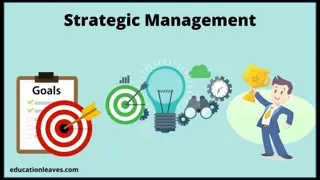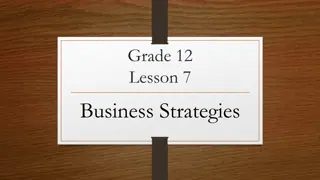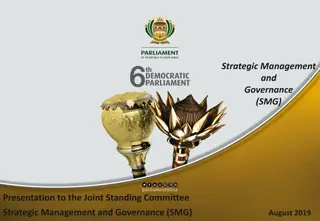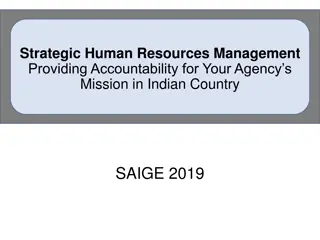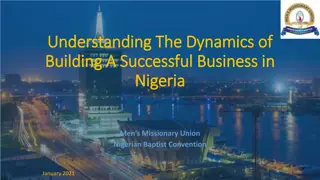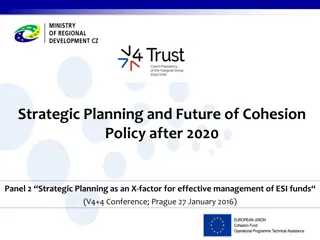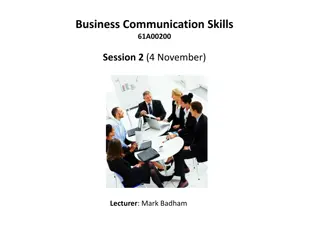Understanding Strategic Management in Business
Strategic management in business involves designing administrative courses of action to achieve success amidst competition and environmental challenges. It encompasses the concept of strategy derived from military science and sports, emphasizing the importance of direction, resource deployment, and adaptation to external factors. The nature of strategy involves contingency planning to address evolving market trends, government policies, and technological advancements.
Download Presentation

Please find below an Image/Link to download the presentation.
The content on the website is provided AS IS for your information and personal use only. It may not be sold, licensed, or shared on other websites without obtaining consent from the author. Download presentation by click this link. If you encounter any issues during the download, it is possible that the publisher has removed the file from their server.
E N D
Presentation Transcript
Strategic Management MSMSR/BBA/601 (Core) Dr. Akshita Sharma Asst. Prof. (MSMSR) MATS University, Pandri, Raipur (C.G.) Strategic Management MSMSR/BBA/601 (Core) 1
Text Books C.N. Sonttakke, Strategic Management, Kalyani Publication Subbarao, Business Policy and Strategic Management, HPH. Dr. Aswathappa, Business Environment for Strategic Management, Tata McGraw Hill. Charles W.L Hill and Gareth R. Jones, Strategic Management an Integrated Approach, Cengage Learning Azhar Kazmi, Business Policy and Strategic Management, Tata McGraw Hill C. AppaRao; Strategic Management and Business Policy, Excel Books. Ghosh P.K., Business Policy and Strategic Planning and Management, Tata McGraw Hill. Pillai, Strategic Management, Lawerence, Business Policy and Strategic Management, Tata McGraw Hill. Sathyashekar : Business Policy and Strategic Management, I.K International Publishing House Pvt. Ltd. Strategic Management MSMSR/BBA/601 (Core) 2
MODULE I Introduction to Strategic Management- Introduction, Meaning and Definition, Need, Process of Strategic Management, Strategic Decision Making, Strategic Management Approaches Strategic Management MSMSR/BBA/601 (Core) 3
Module Content S. no 1 Topics Page no. Introduction, Meaning and Definition of Strategic Management 2 3 4 5 Need of Strategic Management Process of Strategic Management Strategic Decision Making Strategic Management Approaches Strategic Management MSMSR/BBA/601 (Core) 4
Introduction, Meaning and Definition of Strategic Management The concept of strategy The concept of strategy in business has been borrowed from military science and sports where it implies out- maneuvering the opponent. The term strategy began to be used in business with increase in competition and complexity of business operations. A strategy is an administrative course of action designed to achieve success in the face of difficulties. It is a plan for meeting challenges posed by the activities of competitors and environmental forces. Strategy is the complex plan for bringing the organization from a given state to a desired position in a future period of time. For example, if management anticipates price-cut by competitors, it may decide upon a strategy of launching an advertising campaign to educate the customers and to convince them of the superiority of its products. Strategic Management MSMSR/BBA/601 (Core) 5
Nature of strategy Strategy is a contingent plan as it is designed to meet the demands of a difficult situation. Strategy provides direction in which human and physical resources will be deployed for achieving organizational goals in the face of environmental pressure and constraints. Strategy relates an organization to its external environment. Strategic decisions are primarily concerned with expected trends in the market, changes in government policy, technological developments etc. Strategy is an interpretative plan formulated to give meaning to other plans in the light of specific situations. Strategic Management MSMSR/BBA/601 (Core) 6
Introduction, Meaning and Definition of Strategic Management Strategy determines the direction in which the organization is going in relation to its environment. It is the process of defining intentions and allocating or matching resources to opportunities and needs, thus achieving a strategic fit between them. Business strategy is concerned with achieving competitive advantage. The effective development and implementation of strategy depends on the strategic capability of the organization, which will include the ability not only to formulate strategic goals but also to develop and implement strategic plans through the process of strategic management. A strategy gives direction to diverse activities, even though the conditions under which the activities are carried out are rapidly changing. Strategic Management MSMSR/BBA/601 (Core) 7
Introduction, Meaning and Definition of Strategic Management The strategy describes the way that the organization will pursue its goals, given the changing environment and the resource capabilities of the organization. It provides an understanding of how the organization plans to compete. It is the determination and evaluation of alternatives available to an organization in achieving its objectives and mission and the selection of appropriate alternatives to be pursued. It is the fundamental pattern of present and planned objectives, resource deployments, and interactions of a firm with markets, competitors and other environmental factors. Strategic Management MSMSR/BBA/601 (Core) 8
A good strategy should specify; What is to be accomplished Where, i.e., which product/markets it will focus on How i.e., which resources and activities will be allocated to each product/market to meet environmental opportunities and threats and to gain a competitive advantage Strategic Management MSMSR/BBA/601 (Core) 9
Introduction, Meaning and Definition of Strategic Management Definition; Strategic management is the process by which top management determines the long-term direction of the organization by ensuring that careful formulation, implementation and continuous evaluation of strategy take place. Strategic Management MSMSR/BBA/601 (Core) 10
Components of strategy 1. Scope; refers to the breadth of a firm s strategic domain i.e., the number and types of industries, product lines, and markets it competes in or plans to enter. 2. Goals and objectives; these specify desires such as volume growth, profit contribution or return on investment over a specified period. 3. Resource deployment; strategy should specify how resources are to be obtained and allocated across businesses, product/markets, financial departments, and activities.. Strategic Management MSMSR/BBA/601 (Core) 11
Components of strategy 4. Identification of a sustainable competitive advantage; it refers to examining the market opportunities in each business and product-market and the firm s distinctive competencies or strengths relative to competitors. 5. Synergy; this exists when the firm s businesses, products, markets, resource deployments and competencies complement one another i.e., the whole becomes greater than the sum of its parts( 2+2=5) Strategies can be classified into corporate, business-unit and functional strategies. Strategic Management MSMSR/BBA/601 (Core) 12
Strategic Management Strategic management is the process by which top management determines the long-term direction of the organization by ensuring that careful formulation, implementation and continuous evaluation of strategy take place. The strategic management process The process can be broken down into three phases; Strategy formulation Strategy implementation Strategy control Strategic Management MSMSR/BBA/601 (Core) 13
The strategic management process Strategy formulation involves; Defining the organization s guiding philosophy & purpose or mission. Establishing long-term objectives in order to achieve the mission. Selecting the strategy to achieve the objectives. Strategy implementation involves; Establishing short-range objectives, budgets and functional strategies to achieve the strategy. Strategic Management MSMSR/BBA/601 (Core) 14
The strategic management process Strategy control involves the following; Establishing standards of performance. Monitoring progress in executing the strategy. Initiating corrective actions to ensure commitment to the implementation of the strategy. Strategic Management MSMSR/BBA/601 (Core) 15
Needs of strategic management It provides the organization with consistency of action i.e. helps ensure that all organizational units are working toward the same objectives (direction). The process forces managers to be more proactive and conscious of their environments i.e. to be future oriented. It provides opportunity to involve different levels of management, encourage the commitment of participating managers and reducing resistance to proposed change. Strategic Management MSMSR/BBA/601 (Core) 16
Process of Strategic Management Strategic management is a continuous process that appraises the business and industries in which the organization is involved; appraises it s competitors; and fixes goals to meet all the present and future competitor s and then reassesses each strategy. Strategic management process has following four steps: Environmental Scanning- Environmental scanning refers to a process of collecting, scrutinizing and providing information for strategic purposes. It helps in analyzing the internal and external factors influencing an organization. After executing the environmental analysis process, management should evaluate it on a continuous basis and strive to improve it. Strategic Management MSMSR/BBA/601 (Core) 17
Process of Strategic Management Strategy Formulation- Strategy formulation is the process of deciding best course of action for accomplishing organizational objectives and hence achieving organizational purpose. After conducting environment scanning, managers formulate corporate, business and functional strategies. Strategy Implementation- Strategy implementation implies making the strategy work as intended or putting the organization s chosen strategy into action. Strategy implementation includes designing the organization s structure, distributing resources, developing decision making process, and managing human resources. Strategic Management MSMSR/BBA/601 (Core) 18
Process of Strategic Management Strategy Evaluation- Strategy evaluation is the final step of strategy management process. The key strategy evaluation activities are: appraising internal and external factors that are the root of present strategies, measuring performance, and taking remedial/corrective actions. Evaluation makes sure that the organizational strategy as well as it s implementation meets the organizational objectives. Strategic Management MSMSR/BBA/601 (Core) 19
Strategic decision-making It is a process of understanding the interaction of decisions and their impact upon the organization to gain an advantage. Wrong decisions taken at the wrong time, may result in catastrophic consequences. In other words, the power of strategic thinking lies in combining the power of the right decision with the right time. To remain competitive and survive, organizations must make decisions that will maximize short-term results and minimize long-term risks. Strategic decision- making uncovers the future possibilities for a company and those options that can be implemented to achieve success. Strategic and data-driven strategies are gaining trends in the business world. Strategic Management MSMSR/BBA/601 (Core) 20
Strategic decision-making The process of strategic decision-making combines the five basic steps of the decision-making process with the concepts of opportunity, threat, countervailing factors, and risk. The process of strategic decision-making is the lifeblood of your organization. As a business owner, it s your responsibility to make decisions that will help your company survive, grow and thrive. Strategic Decision Making: Reasons and Its Importance The organization must perform better in the future whether the present is better or worse. It is necessary to make strategic decisions to overcome the obstacles that come in the way of the organization s progress. Strategic Management MSMSR/BBA/601 (Core) 21
Why Strategic decision-making is the most essential thing for an organization? An important step in all organizations. This process facilitates organizational learning to take place, improve performance and organizational outcomes and reduce the probability of strategic failure or competition. It provides business intelligence reports for organizations to study and predict the future trends A skill and it s important to learn it and practice. Strategic decision-making is an essential skill for today s leaders. It s not a skill that should be picked up and used once or twice and then forgotten. Strategic decision-making can provide your organization with a competitive advantage, and it s important to maintain your strategic decision-making skills and continue to develop them over time. Strategic Management MSMSR/BBA/601 (Core) 22
Why Strategic decision-making is the most essential thing for an organization? One of the most important activities any organization can carry out. Strategic decisions are decisions that require a high degree of responsibility and focus on long-term objectives. They need a lot of knowledge about many things including the processes, systems, and policies. In addition to that, decisions need to be planned before they are carried out. Power BI visuals is one such tools which is secured and loaded with options for making better and smarter decisions. Also involves the process of implementation. Strategic decision-making is all about making the right decisions at the right time. Strategic Management MSMSR/BBA/601 (Core) 23
Why Strategic decision-making is the most essential thing for an organization? This is the process of making a decision and then implementing that decision. Decision-making is not about making a decision, and then not acting on it. Implementation is the process of actually doing the work. A key tool to drive business growth. It is the way to find out what is the best way of achieving a business objective and what the risks are. This is why organizations should have a decision-making process that includes a well-defined set of policies and rules which are adhered to by all. You can also use different data analytics tools and data discovery tools for helping you taking better decisions. Strategic Management MSMSR/BBA/601 (Core) 24
Assignment Q.1.Write Short Note on:- a. Strategic Management b. Components of strategy. Q.2. Define process of strategy management. Q.3. Explain Strategic Decision making. 25
MODULE II Environmental Appraisal- The concept of Environment, The Company and its Environment, Porter s Five Forces Model, Scanning the Environment, Technological, Social, Cultural, Demographic, Political, Legal and Other Environments Forces, Internal Analysis, Competitive Advantage, Value Chain Analysis, SWOT Analysis. Strategic Management MSMSR/BBA/601 (Core) 26
Environmental Appraisal There are numerous factors that affect the organisation and its operations. These factors can influence the organisation in both positive as well as negative ways. Identifying the issues and challenges existing in the external environment is extremely important for an organisation. In order to identify the factors in external environment, an appraisal process of the industry's environment is necessary. Environmental appraisal facilitates the managers with the ability to study the competitive structure and competitive position of the organisation along with the position of its competitors. By analyzing and appraising the external environment, the existing opportunities and threats can be identified. It is the responsibility of the managers to avoid the threats and to reap the benefits from the opportunities in the market. Strategic Management MSMSR/BBA/601 (Core) 27
Environmental Appraisal Environmental appraisal also helps the managers in analyzing the effects of globalization on the level of competition within a particular industry. It is well-known that business environment never remains stable rather keeps on changing rapidly. As the businesses grows and expands, the changes in external environment compels the organisations to make efficient strategies to deal with the contingency situations. Environmental appraisal also allows an organisation to study the steps taken by competitors in the market. By appraising the external environment the companies can improve their internal capabilities and strengths for adapting to the changes in the external. environment. Strategic Management MSMSR/BBA/601 (Core) 28
Definition of Environmental Appraisal According to Abell : "Environmental appraisal is the identification, measurement, and assessment of environmental impacts". Strategic Management MSMSR/BBA/601 (Core) 29
Levels/Components of Environmental Appraisal By analyzing the external environment of a business the marketers are able to identify and highlight the opportunities from the threats and strengths from the weaknesses. The factors which are not dependent on organisation and their existence is not based on the activities of the organisation are called as external factors. While strengths and weaknesses are internal. Opportunities and threats are external and are not in control of the organisation. Opportunities are those situations that the organisations can use to their advantage. While threats are those negative situations that if not tackled promptly can harm the well-being of the organisation. Analyzing the external environment requires analyzing following areas : Strategic Management MSMSR/BBA/601 (Core) 30
Levels/Components of Environmental Appraisal 1) Environmental Scanning : In environmental scanning the broad environmental factors are analysed and studied. These factors are not a part of the organization's internal environment and hence are uncontrollable in nature. These factors influence the businesses in a significant manner. These factors are a part of the macro environment or the general environment. The common macro environmental factors are economic, political, legal, technological, social, etc. 31 Strategic Management MSMSR/BBA/601 (Core)
Levels/Components of Environmental Appraisal 2) Industry Analysis : Industry analysis is a tool which is used to assess the degree of competition and complexity within a particular industry. With the help of industry analysis, the marketers study and scrutinize the macro environmental factors that influence a particular industry. Industrial analysis helps the strategic leaders formulate various strategies to neutralize the threats and reap the benefits from the opportunities. Various environmental forces to be studied in the industry analysis are the bargaining power of buyers and suppliers, position of business and competitors and threats of new entrants as well as the substitutes within the industry. 32 Strategic Management MSMSR/BBA/601 (Core)
Levels/Components of Environmental Appraisal 3) Competitive Analysis : While appraising the external environment, it is very important to analyse the strengths and weaknesses of the existing and probable competitors. It helps the organisation to formulate the strategies required to survive and succeed in the highly competitive environment. It also outlines the strategies adopted by the competitors. The influence of competition is directly proportional to the degree of concentration in the industry, i.e., if the concentration of the industry is high, the influence of competition is high, and vice versa. Competitive analysis helps the organisations in identifying threats and opportunities by providing defensive and offensive strategic moves. Strategic Management MSMSR/BBA/601 (Core) 33
Process of Environmental Appraisal The process of environmental appraisal includes the following steps : 1) Understand Nature of Environment :- Before starting the environmental appraisal, the strategists must understand the nature, i.e., the volatility of external environment. The volatility here implies to the changes in the environment. To understand the nature of environment, the strategic leaders need to answer following questions : Is the environment stable or dynamic? In which ways does the environment change? Are the changes identifiable? Answering these questions would help in deciding the future course of actions. Strategic Management MSMSR/BBA/601 (Core) 34
Process of Environmental Appraisal 2) Analyze the Past Influences of Environmental Factors : - Once, the nature of external environment is identified, the next step is to identify the factors that have influenced the performance of organisation in the past. Analyzing these factors will help in planning and formulating strategies to handle future scenarios. 3) Identify Critical Competitive Forces : The next step is to identify the key competitive forces existing within the industry with the help of structural analysis. This step helps to analyze the organization's current position, the bargaining power of buyers and suppliers, the new entrants in the industry, and the existing competitors of the organisation. Strategic Management MSMSR/BBA/601 (Core) 35
Process of Environmental Appraisal 4) Analyze the Strategic Position : In this step, the managers analyse the strategic position of the organisation in relation to its competitors in terms of resources, customers, etc. To identify and analyse the strategic position of an organisation, following ways should be adopted: Growth/Share analysis Attractiveness analysis Strategic group analysis Study of market segments and market power Competitor analysis 5) Identify the Opportunities and Threats : - Identify the opportunities and threats prevailing in the environment. Formulate efficient strategies to reap the benefits from the opportunities so that the threats can be neutralized. The selection of strategy and effective utilization of selected resources in an effective manner is crucial for this stage. 36 Strategic Management MSMSR/BBA/601 (Core)
The concept of Environment The environment is a major source of change. Some firms become victims of this change while others use it to their advantage. The purpose of environmental analysis is to enable the firm to turn change to its advantage by being proactive. Characteristics of the environment are; It is unique to every organization. It is constantly changing. One level is controllable while the other (remote-PESTEL) is uncontrollable. It is a source of Opportunities, Threats, Strengths & Weaknesses. Environmental analysis can be divided into two major steps; a. Defining; determining the relevant environmental forces. b. Scanning & forecasting; collecting information concerning the defined environment. Strategic Management MSMSR/BBA/601 (Core) 37
The Company and its Environment Understanding the environment that surrounds an organization is important to the executives in charge of the organizations. There are several reasons for this. First, the environment provides resources that an organization needs in order to create goods and services. In the 17th century, British poet John Donne famously noted that no man is an island. Similarly, it is accurate to say that no organization is self-sufficient. As the human body must consume oxygen, food, and water, an organization needs to take in resources such as labor, money, and raw materials from outside its boundaries. Subway, for example, simply would cease to exist without the contributions of the franchisees that operate its stores, the suppliers that provide food and other necessary inputs, and the customers who provide Subway with money through purchasing its products. An organization cannot survive without the support of its environment. Strategic Management MSMSR/BBA/601 (Core) 38
The Company and its Environment Second, the environment is a source of opportunities and threats for an organization. Opportunities are events and trends that create chances to improve an organization s performance level. In the late 1990s, for example, Jared Fogle s growing fame created an opportunity for Subway to position itself as a healthy alternative to traditional fast-food restaurants. Threats are events and trends that may undermine an organization s performance. Subway faces a threat from some upstart restaurant chains. Saladworks, for example, offers a variety of salads that contain fewer than 500 calories. Noodles and Company offers a variety of sandwiches, pasta dishes, and salads that contain fewer than 400 calories. These two firms are much smaller than Subway, but they could grow to become substantial threats to Subway s positioning as a healthy eatery. Strategic Management MSMSR/BBA/601 (Core) 39
The Company and its Environment Executives must also realize that virtually any environmental trend or event is likely to create opportunities for some organizations and threats for others. This is true even in extreme cases. In addition to horrible human death and suffering, the March 2011 earthquake and tsunami in Japan devastated many organizations, ranging from small businesses that were simply wiped out to corporate giants such as Toyota whose manufacturing capabilities were undermined. As odd as it may seem, however, these tragic events also opened up significant opportunities for other organizations. The rebuilding of infrastructure and dwellings requires concrete, steel, and other materials. Japanese concrete manufacturers, steelmakers, and construction companies are likely to be very busy in the years ahead. 40 Strategic Management MSMSR/BBA/601 (Core)
The Company and its Environment Third, the environment shapes the various strategic decisions that executives make as they attempt to lead their organizations to success. The environment often places important constraints on an organization s goals, for example. A firm that sets a goal of increasing annual sales by 50 percent might struggle to achieve this goal during an economic recession or if several new competitors enter its business. Environmental conditions also need to be taken into account when examining whether to start doing business in a new country, whether to acquire another company, and whether to launch an innovative product, to name just a few. Strategic Management MSMSR/BBA/601 (Core) 41
Porter's Five Forces model Porter's Five Forces is a model that identifies and analyzes five competitive forces that shape every industry and helps determine an industry's weaknesses and strengths. Five Forces analysis is frequently used to identify an industry's structure to determine corporate strategy. Porter's model can be applied to any segment of the economy to understand the level of competition within the industry and enhance a company's long-term profitability. The Five Forces model is named after Harvard Business School professor, Michael E. Porter. Strategic Management MSMSR/BBA/601 (Core) 42
Porter's Five Forces model Porter's 5 forces are: Competition in the industry Potential of new entrants into the industry Power of suppliers Power of customers Threat of substitute products Strategic Management MSMSR/BBA/601 (Core) 43
1. Competition in the Industry The first of the Five Forces refers to the number of competitors and their ability to undercut a company. The larger the number of competitors, along with the number of equivalent products and services they offer, the lesser the power of a company. Suppliers and buyers seek out a company's competition if they are able to offer a better deal or lower prices. Conversely, when competitive rivalry is low, a company has greater power to charge higher prices and set the terms of deals to achieve higher sales and profits. Competitors are many They are roughly equal in size Industry growth is slow, leading to fights for market share The product lacks differentiation or switching costs Fixed costs are high and the product is perishable Exit barriers are high. Strategic Management MSMSR/BBA/601 (Core) 44
2. Potential of New Entrants Into an Industry A company's power is also affected by the force of new entrants into its market. The less time and money it costs for a competitor to enter a company's market and be an effective competitor, the more an established company's position could be significantly weakened. An industry with strong barriers to entry is ideal for existing companies within that industry since the company would be able to charge higher prices and negotiate better terms. Strategic Management MSMSR/BBA/601 (Core) 45
3. Power of Suppliers The next factor in the Porter model addresses how easily suppliers can drive up the cost of inputs. It is affected by the number of suppliers of key inputs of a good or service, how unique these inputs are, and how much it would cost a company to switch to another supplier. The fewer suppliers to an industry, the more a company would depend on a supplier. As a result, the supplier has more power and can drive up input costs and push for other advantages in trade. On the other hand, when there are many suppliers or low switching costs between rival suppliers, a company can keep its input costs lower and enhance its profits. It is made up of a few firms There are few or no substitute products The product is unique or differentiated There exists supplier switching costs It can integrate forward to produce the industry s product. Strategic Management MSMSR/BBA/601 (Core) 46
4. Power of Customers The ability that customers have to drive prices lower or their level of power is one of the Five Forces. It is affected by how many buyers or customers a company has, how significant each customer is, and how much it would cost a company to find new customers or markets for its output. A smaller and more powerful client base means that each customer has more power to negotiate for lower prices and better deals. A company that has many, smaller, independent customers will have an easier time charging higher prices to increase profitability. The buyers are few and they buy in large volumes The product is not differentiated, is substitutable and there are other alternative suppliers. The buyer has little switching costs The buyer can integrate backward to make the industry s product. Strategic Management MSMSR/BBA/601 (Core) 47
5. Threat of Substitutes The last of the Five Forces focuses on substitutes. Substitute goods or services that can be used in place of a company's products or services pose a threat. Companies that produce goods or services for which there are no close substitutes will have more power to increase prices and lock in favorable terms. When close substitutes are available, customers will have the option to forgo buying a company's product, and a company's power can be weakened. Understanding Porter's Five Forces and how they apply to an industry, can enable a company to adjust its business strategy to better use its resources to generate higher earnings for its investors. Strategic Management MSMSR/BBA/601 (Core) 48
What Are Some Drawbacks of Porter's Five Forces? The Five Forces model has some drawbacks, including that it is backward- looking, making its findings mostly relevant only in the short term; that limitation is compounded by the impact of globalization. Another big drawback is the tendency to try to use the five forces to analyze an individual company, versus a broad industry, which is how the framework was intended. Also problematic is that the framework is structured so that each company is placed in one industry group when some companies straddle several. Another issue includes the need to assess all five forces equally when some industries aren't as heavily impacted by all five. What's the Difference Between Porter's Five Forces and SWOT Analysis? Porter's 5 Forces and SWOT (strengths, weaknesses, opportunities, & threats) analysis are both tools used to analyze and make strategic decisions. Companies, analysts, and investors use Porter's 5 Forces to analyze the competitive environment within an industry, while they tend to use a SWOT analysis to look more deeply within an organization to analyze its internal potential. Strategic Management MSMSR/BBA/601 (Core) 49
Scanning the Environment Environmental scanning is a process of gathering information about the events and their relationship with the internal and external environment of the organization. The primary aim of environmental scanning is to find out the future prospects of business organization. As a significant resource to the management, the Environmental Scanning Committee enables the management to make decisions from fundamental analysis of historical events to estimate future events. The committee also helps in creating action plans to address these upcoming events, analyzing action plans and arranging appropriate resources for those plans, and putting management in contact with fellow employees with the knowledge set to provide quality data for decision making. Environmental Scanning Definition - The process of collecting, evaluating, and delivering information for a strategic purpose is defined as environmental scanning. The process of environmental scanning requires both accurate and personalized data on the business environment in which the organization is operating or considering entering. Strategic Management MSMSR/BBA/601 (Core) 50








